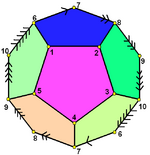57-cell
| 57-cell | |
|---|---|
| Type | Abstract regular 4-polytope |
| Cells | 57 hemi-dodecahedra
|
| Faces | 171 {5} |
| Edges | 171 |
| Vertices | 57 |
| Vertex figure | hemi-icosahedron |
| Schläfli type | {5,3,5} |
| Symmetry group | order 3420 Abstract L2(19) |
| Dual | self-dual |
| Properties | Regular |
In mathematics, the 57-cell (pentacontakaiheptachoron) is a self-dual abstract regular 4-polytope (four-dimensional polytope). Its 57 cells are hemi-dodecahedra. It also has 57 vertices, 171 edges and 171 two-dimensional faces.
The symmetry order is 3420, from the product of the number of cells (57) and the symmetry of each cell (60). The symmetry abstract structure is the projective special linear group of the 2-dimensional vector space over the finite field of 19 elements, L2(19).
It has Schläfli type {5,3,5} with 5 hemi-dodecahedral cells around each edge. It was discovered by H. S. M. Coxeter (1982).
Perkel graph

The vertices and edges form the Perkel graph, the unique distance-regular graph with intersection array {6,5,2;1,1,3}, discovered by Manley Perkel (1979).
See also
- 11-cell – abstract regular polytope with hemi-icosahedral cells.
- 120-cell – regular 4-polytope with dodecahedral cells
- Order-5 dodecahedral honeycomb - regular hyperbolic honeycomb with same Schläfli type, {5,3,5}. (The 57-cell can be considered as being derived from it by identification of appropriate elements.)
References
- "Ten toroids and fifty-seven hemidodecahedra", Geometriae Dedicata 13 (1): 87–99, 1982, doi:10.1007/BF00149428.
- Abstract Regular Polytopes, Encyclopedia of Mathematics and its Applications, 92, Cambridge: Cambridge University Press, 2002, pp. 185–186, 502, doi:10.1017/CBO9780511546686, ISBN 0-521-81496-0, https://books.google.com/books?id=JfmlMYe6MJgC&pg=PA185
- Perkel, Manley (1979), "Bounding the valency of polygonal graphs with odd girth", Canadian Journal of Mathematics 31 (6): 1307–1321, doi:10.4153/CJM-1979-108-0.
- "The Regular 4-dimensional 57-cell", ACM SIGGRAPH 2007 Sketches, SIGGRAPH '07, New York, NY, USA: ACM, 2007, doi:10.1145/1278780.1278784, http://www.cs.berkeley.edu/~sequin/PAPERS/2007_SIGGRAPH_57Cell.pdf
- The Classification of Rank 4 Locally Projective Polytopes and Their Quotients, 2003, Michael I Hartley
External links
- Siggraph 2007: 11-cell and 57-cell by Carlo Sequin
- Weisstein, Eric W.. "Perkel graph". http://mathworld.wolfram.com/PerkelGraph.html.
- Perkel graph
- Klitzing, Richard. "Explanations Grünbaum-Coxeter Polytopes". https://bendwavy.org/klitzing/dimensions/../explain/gc.htm.
